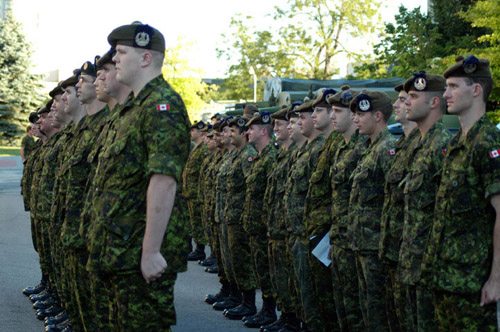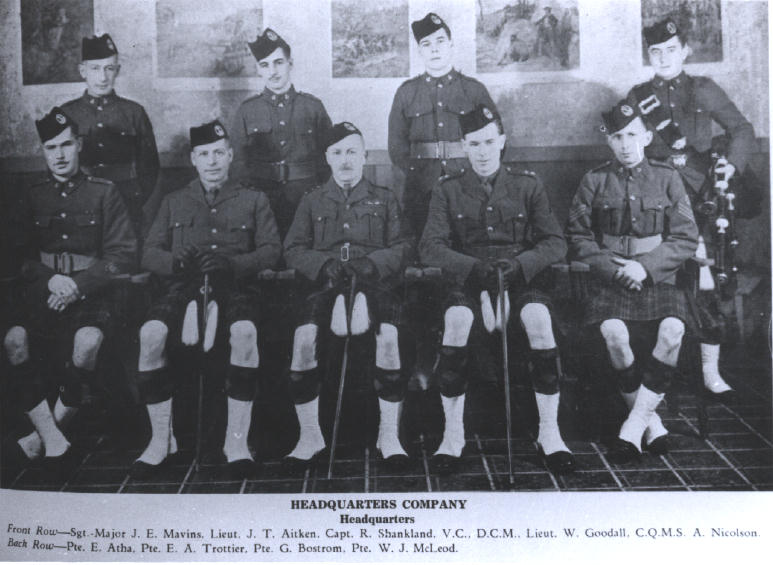|
-
17th August 17, 05:56 PM
#21
Last edited by OC Richard; 18th August 17 at 03:54 AM.
Proud Mountaineer from the Highlands of West Virginia; son of the Revolution and Civil War; first Europeans on the Guyandotte
-
The Following User Says 'Aye' to OC Richard For This Useful Post:
-
17th August 17, 06:43 PM
#22
 Originally Posted by OC Richard

To my mind "plume" conjures up a very different thing, like a big ostrich feather worn in a musketeer or pirate hat.
The Black Watch wore red hackles in their feather bonnets but also in their Tam O Shanters. The TOS hackles are of course much shorter.
I can't recall seeing any of the Scottish Highland regiments wearing hackles in their Glengarries.
Various regiments also wore hackles in their sun helmets.
With the formation of The Royal Regiment Of Scotland it became hackles in the TOS for all battalions:
1SCOTS black
2SCOTS white
3SCOTS red
4SCOTS blue
5SCOTS green
6SCOTS grey
7SCOTS purple
The pipers of the Cameron Highlanders wore eagle feathers in their Glens, while pipers of several regiments wore a blackcock's tail.
The Camerons/Queens Own Highlanders/Highlanders/ successively all wore the blue hackle on their glens. Cameronians wore black with certain orders of dress with both the glen and TOS. The RSDG pipes and drums wear white hackles with glens in certain orders of dress.
-
-
18th August 17, 03:58 AM
#23
Last edited by OC Richard; 18th August 17 at 04:20 AM.
Proud Mountaineer from the Highlands of West Virginia; son of the Revolution and Civil War; first Europeans on the Guyandotte
-
-
18th August 17, 05:59 AM
#24
The blue hackle didn't come on the scene until after the BEF withdrew back to the UK at the beginning of ww2. It was given to the Camerons as a gesture because of the banning of kilts being used operationally and they had put up the biggest fight to keep them. As for plumes, I tend to fall in line with you, the Scots DG's wear a plume on their bearskins that bends over the top of the headdress rather than a hackle. As for the BW red hackle in the glen, I agree, it does look very odd, considering they didn't usually wear a badge if they had the hackle on, that was part of it's mystique.
-
-
18th August 17, 10:12 AM
#25
Great pictures - fascinating stuff!
-
-
19th August 17, 03:00 AM
#26
Red hackles
 Originally Posted by 48HofC

The plumes are actually called hackles and a usually made from vulture feathers by tradition. Most of the Highland regiments , Gordons, Argylls, Queens Own Highrs, RHF wore white hackles except for the BW with red. The military Band of the SCOTS wore red for a while, not sure if they still do, and the Scots Guards pipers wear red and blue. White has been the standard for years.
Found this image online. I'm sure I also read somewhere that the Seaforth pipes and drums wore red.
-
-
19th August 17, 05:08 AM
#27
 Originally Posted by Jags

Found this image online. I'm sure I also read somewhere that the Seaforth pipes and drums wore red. 
The Seaforth pipers never wore feather bonnets, and the drummers wore white hackles all the way back to their formation in the early 1880's. Seaforth antecedent regiments might have since privately raised regiments liked to stand out from each other.
-
The Following User Says 'Aye' to 48HofC For This Useful Post:
-
19th August 17, 10:15 AM
#28
Red hackles
 Originally Posted by 48HofC

The Seaforth pipers never wore feather bonnets, and the drummers wore white hackles all the way back to their formation in the early 1880's. Seaforth antecedent regiments might have since privately raised regiments liked to stand out from each other.
This is from www.blackwatchforums.co.uk from 2012. The post reads:
The military band as well as drummers of The Seaforth Highlanders wore red hackles. So, one has to be cautious about using the red hackle for regimental ID. Also wearing the red hackle were the military band of the 1st Argylls (91st) and the military bands of both battalions of the HLI.
There is an anecdote about King George VI who after WW2 saw the Seaforth Band at Balmoral Castle wearing red hackles. He admonished them noting that only the Black Watch was authorized to wear red hackles. Not wishing to get on the wrong side of KG VI, the Seaforth bandsmen temporarily switched to white hackles for the duration of their stay at Ballater/Balmoral.
A reply reads:
You are indeed correct about the wearing of the Red Hackle. The Red Hackle was presented to the Black Watch on the 4th of June 1795.
In 1822, from a mistaken direction in a book of dress for the guidance of the army, some of the other Highland regiments concluded that they also had a right to wear "a red vulture feather". The 42d, however, remonstrated, and their representations at headquarters called forth the following memorandum:-
"For Officers commanding Highland Regiments.
"Horse Guards, 20th Aug, 1822.
"The red vulture feather prescribed by the recent regulations for Highland regiments is intended to be used exclusively by the Forty-Second Regiment: other Highland corps will be allowed to continue to wear the same description of feather that may have been hitherto in use.
"H. Torrens, Adjutant-General".
And I found this from 2023 from www.victorianwars.com:
Regarding wearing of red hackles by regiments not named The Black Watch: The military bands of both regular battalions of the Seaforth Highlanders wore a red hackle in the feather bonnet and on the foreign service helmets. This was a legacy from the the 72nd. Only 1st Seaforth drummers wore red hackles; 2nd Bn drummers used white hackles. Concerning the Argyll & Sutherland Highlanders, only the military band of the 91st wore the red hackle while that of the 93rd had a white one. The military bands of both battalions of the Highland Light Infantry dressed with a red hackle. The post-1881 HLI inherited the dress of its military bands from the 74th Highlanders including, I believe, the red hackle. On the very last point, I have a little uncertainty since I am away from home and without my reference materials
Last edited by Jags; 19th August 17 at 10:35 AM.
-
-
19th August 17, 04:46 PM
#29
 Originally Posted by Jags

This is from www.blackwatchforums.co.uk from 2012. The post reads:
The military band as well as drummers of The Seaforth Highlanders wore red hackles. So, one has to be cautious about using the red hackle for regimental ID. Also wearing the red hackle were the military band of the 1st Argylls (91st) and the military bands of both battalions of the HLI.
There is an anecdote about King George VI who after WW2 saw the Seaforth Band at Balmoral Castle wearing red hackles. He admonished them noting that only the Black Watch was authorized to wear red hackles. Not wishing to get on the wrong side of KG VI, the Seaforth bandsmen temporarily switched to white hackles for the duration of their stay at Ballater/Balmoral.
A reply reads:
You are indeed correct about the wearing of the Red Hackle. The Red Hackle was presented to the Black Watch on the 4th of June 1795.
In 1822, from a mistaken direction in a book of dress for the guidance of the army, some of the other Highland regiments concluded that they also had a right to wear "a red vulture feather". The 42d, however, remonstrated, and their representations at headquarters called forth the following memorandum:-
"For Officers commanding Highland Regiments.
"Horse Guards, 20th Aug, 1822.
"The red vulture feather prescribed by the recent regulations for Highland regiments is intended to be used exclusively by the Forty-Second Regiment: other Highland corps will be allowed to continue to wear the same description of feather that may have been hitherto in use.
"H. Torrens, Adjutant-General".
And I found this from 2023 from www.victorianwars.com:
Regarding wearing of red hackles by regiments not named The Black Watch: The military bands of both regular battalions of the Seaforth Highlanders wore a red hackle in the feather bonnet and on the foreign service helmets. This was a legacy from the the 72nd. Only 1st Seaforth drummers wore red hackles; 2nd Bn drummers used white hackles. Concerning the Argyll & Sutherland Highlanders, only the military band of the 91st wore the red hackle while that of the 93rd had a white one. The military bands of both battalions of the Highland Light Infantry dressed with a red hackle. The post-1881 HLI inherited the dress of its military bands from the 74th Highlanders including, I believe, the red hackle. On the very last point, I have a little uncertainty since I am away from home and without my reference materials
Very interesting, learn something new every day. Most of my direct knowledge deals with post ww2 Scottish regiments, to much variety to deal with pre 20th century battalion oddities. My research comes from print materials written during the time period I am looking at as well as information gleaned from members of the regiments I have become friends with over the years. I don't put a lot of faith in information found on the internet because the majority of it isn't fact checked and too many people pass it off as genuine 100% accurate material.
-
The Following User Says 'Aye' to 48HofC For This Useful Post:
-
20th August 17, 01:11 AM
#30
 Originally Posted by 48HofC

Very interesting, learn something new every day. Most of my direct knowledge deals with post ww2 Scottish regiments, to much variety to deal with pre 20th century battalion oddities. My research comes from print materials written during the time period I am looking at as well as information gleaned from members of the regiments I have become friends with over the years. I don't put a lot of faith in information found on the internet because the majority of it isn't fact checked and too many people pass it off as genuine 100% accurate material.
Completely agree about internet sources. I only posted as it is at odds with every other photo or description I've seen, where the hackles are white - apart from the 1908 illustration in a previous post. That illustration could have been nonsense of course, or referenced from an old description of the dress.
-
Tags for this Thread
 Posting Permissions
Posting Permissions
- You may not post new threads
- You may not post replies
- You may not post attachments
- You may not edit your posts
-
Forum Rules
|
|






















Bookmarks